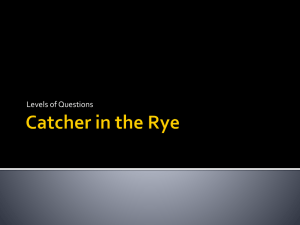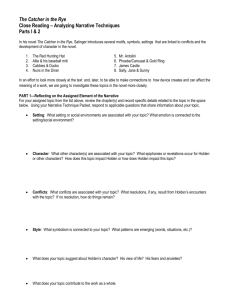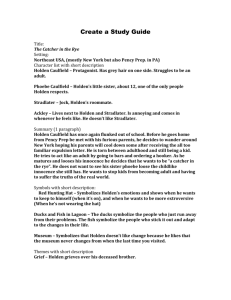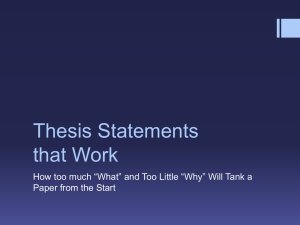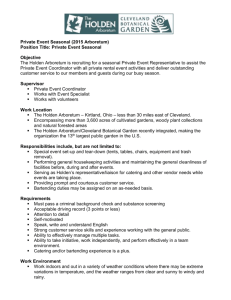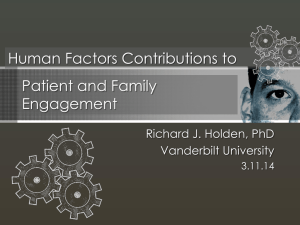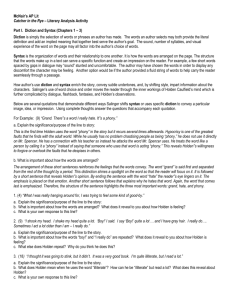Final Draft Essay: THE CATCHER IN THE RYE
advertisement
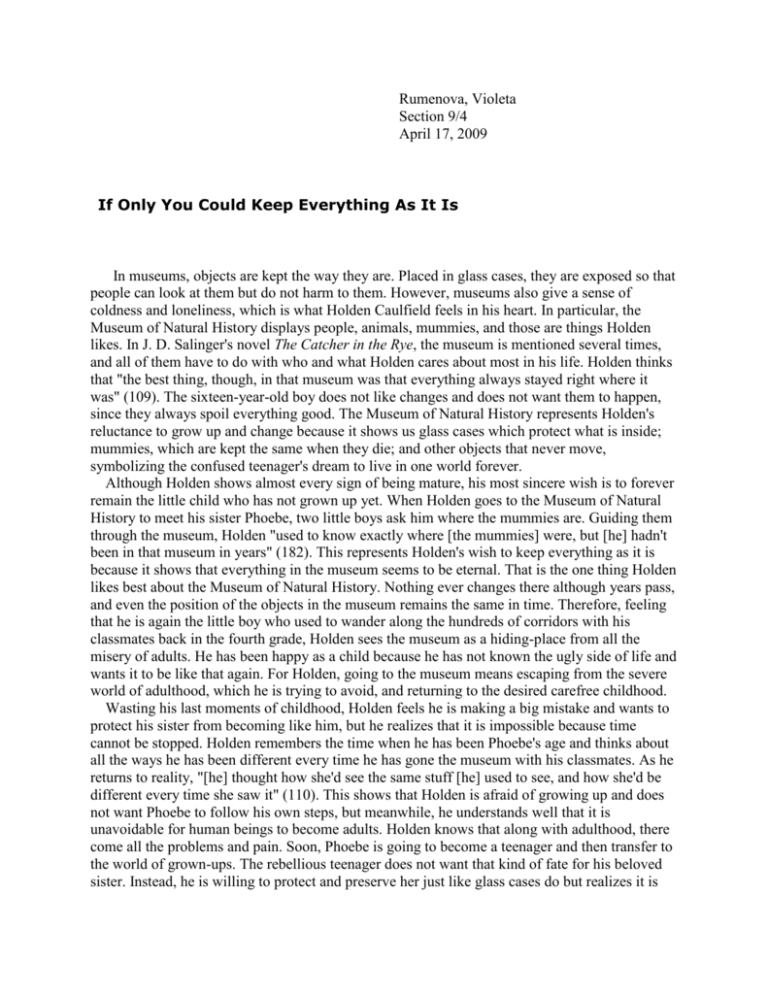
Rumenova, Violeta Section 9/4 April 17, 2009 If Only You Could Keep Everything As It Is In museums, objects are kept the way they are. Placed in glass cases, they are exposed so that people can look at them but do not harm to them. However, museums also give a sense of coldness and loneliness, which is what Holden Caulfield feels in his heart. In particular, the Museum of Natural History displays people, animals, mummies, and those are things Holden likes. In J. D. Salinger's novel The Catcher in the Rye, the museum is mentioned several times, and all of them have to do with who and what Holden cares about most in his life. Holden thinks that "the best thing, though, in that museum was that everything always stayed right where it was" (109). The sixteen-year-old boy does not like changes and does not want them to happen, since they always spoil everything good. The Museum of Natural History represents Holden's reluctance to grow up and change because it shows us glass cases which protect what is inside; mummies, which are kept the same when they die; and other objects that never move, symbolizing the confused teenager's dream to live in one world forever. Although Holden shows almost every sign of being mature, his most sincere wish is to forever remain the little child who has not grown up yet. When Holden goes to the Museum of Natural History to meet his sister Phoebe, two little boys ask him where the mummies are. Guiding them through the museum, Holden "used to know exactly where [the mummies] were, but [he] hadn't been in that museum in years" (182). This represents Holden's wish to keep everything as it is because it shows that everything in the museum seems to be eternal. That is the one thing Holden likes best about the Museum of Natural History. Nothing ever changes there although years pass, and even the position of the objects in the museum remains the same in time. Therefore, feeling that he is again the little boy who used to wander along the hundreds of corridors with his classmates back in the fourth grade, Holden sees the museum as a hiding-place from all the misery of adults. He has been happy as a child because he has not known the ugly side of life and wants it to be like that again. For Holden, going to the museum means escaping from the severe world of adulthood, which he is trying to avoid, and returning to the desired carefree childhood. Wasting his last moments of childhood, Holden feels he is making a big mistake and wants to protect his sister from becoming like him, but he realizes that it is impossible because time cannot be stopped. Holden remembers the time when he has been Phoebe's age and thinks about all the ways he has been different every time he has gone the museum with his classmates. As he returns to reality, "[he] thought how she'd see the same stuff [he] used to see, and how she'd be different every time she saw it" (110). This shows that Holden is afraid of growing up and does not want Phoebe to follow his own steps, but meanwhile, he understands well that it is unavoidable for human beings to become adults. Holden knows that along with adulthood, there come all the problems and pain. Soon, Phoebe is going to become a teenager and then transfer to the world of grown-ups. The rebellious teenager does not want that kind of fate for his beloved sister. Instead, he is willing to protect and preserve her just like glass cases do but realizes it is impossible to remain a child forever. Therefore, Holden finds out that in real life, no one lives 'happily ever after,' people grow up, and cannot prevent themselves or others from the change like it often happens in museums. It bewilders Holden how ancient Egyptians have preserved mummies for thousands of years, something even modern science is not able to do. While waiting for Phoebe in the Museum of Natural History, Holden is talking to the two little boys about the mummies, but it seems that he is posing a question to himself. The rebellious teenager is astonished at the fact that " 'That way they could be buried in their tombs for thousands of years and their faces wouldn't rot or anything. Nobody knows how to do it except the Egyptians' " (183). This shows that Holden wants to be like the Egyptians. Passing years destroy purity and make people more mature. Thus, Holden is willing to know how to preserve everything he loves in time. If he could, he would protect Jane Gallagher and Phoebe so that they do not ever become adults, because adulthood would set Holden apart from his most beloved ones. Stuck between two different worlds, childhood and adulthood, Holden would not be able to be near the new mature Jane and Phoebe, so he wishes he could keep the two girls the way they are - young and pure. In addition, Holden would try to preserve himself in order to remain in his most beloved creatures' sheer and innocent world. For him, mummies are the perfect example of what life should be - immutable. Holden would not use the ancient Egyptians' secret only to preserve Jane and Phoebe but also to fulfill his dream of becoming the catcher in the rye because in that way he would help kids. Going back to his childhood memories, Holden feels sorry about all the times his life has changed unexpectedly. The teenager confesses, "I mean you'd be different in some way -- I can't explain what I mean. And even if I could, I'm not sure I'd feel like it" (110). This shows that Holden reluctantly anticipates all the changes that he has gone through. For instance, his little brother Allie's death has left deep wounds in his soul. His brother's early death is a change Holden hates. Although Holden likes the Museum of Natural History itself, he connects it with all the bad memories from childhood because what cannot be put in a glass case is everybody Holden loves. Thus, having already met the ugly face of real life, Holden wants to protect by himself all those little kids who do not know what adulthood brings and want to jump into it as soon as possible. That is exactly why Holden wants to stay at the edge of the cliff and just be the catcher in the rye. In other words, he will always remain ready to save a child from falling into one different insecure world of grown-ups where the only things that do not change are kept in museums. Allowing Phoebe to take care of him and does not let him run away is the final way in which Holden tries to make a journey back to childhood. Holden has got tired from making himself look and act like a man all the time in front of others because this is not his real self, which is just the opposite. The teenager feels that he has already missed the last train to childhood and knows that he cannot go back in time. However, he wants at least, to be able to preserve everyone he loves,"stick them in one of those big glass cases and just leave them alone. . . [because] it's too bad anyway" (110). That is exactly what the Museum of Natural History does. It keeps all the objects inside safe and preserves them in time. Meanwhile, people have the opportunity to look at those objects and observe them carefully. If Holden could see everyone he loves through glass cases the way he likes them, he would remain forever one happy little boy who does not have to go out and meet reality. Although Holden ends up meeting a psychologist because of his unstable condition, J. D. Salinger's novel The Catcher in the Rye teaches us the most important lesson about life, since it does not show us one Utopian world but tells us the story of a problematic traumatized teenager who can be any one of us.
